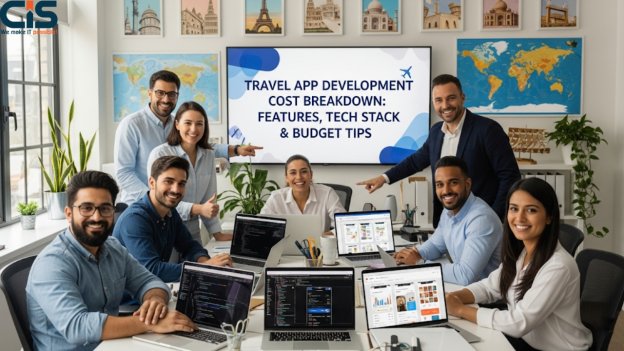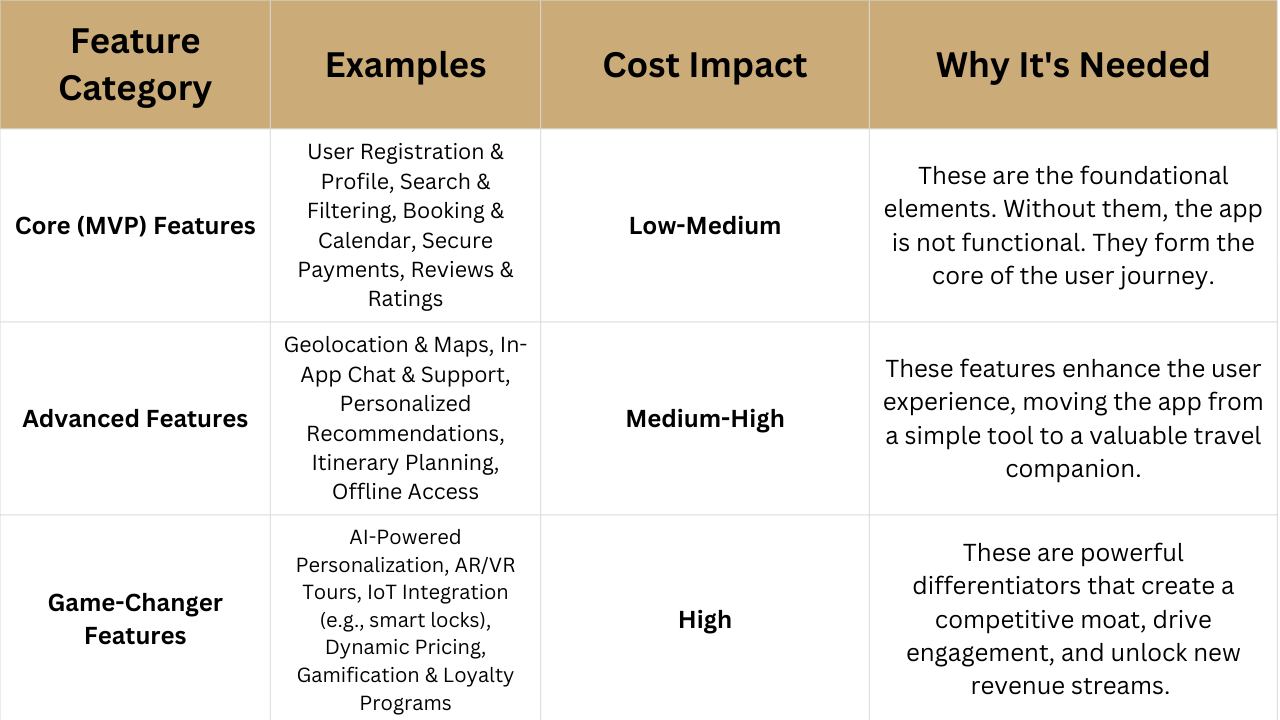
The most common question we hear from founders, CTOs, and enterprise leaders isn't "Can you build it?" but rather, "What will it really cost?" In the dynamic world of travel technology, this question is loaded. You're not just buying code; you're investing in a digital experience, a revenue engine, and a competitive advantage. Answering this question with a vague "it depends" is a disservice.
The truth is, the cost of developing a travel app can range from $25,000 for a streamlined Minimum Viable Product (MVP) to well over $250,000 for a complex, AI-driven enterprise platform. The difference lies in the details: complexity, features, technology, and the expertise of the team you hire.
This guide provides a transparent, no-fluff breakdown for leaders who need to build a realistic budget and make informed decisions. We'll dissect the factors that drive costs, explore the features that matter, and offer expert tips to maximize your return on investment.
🔑 Key Takeaways: The Executive Summary
- Budget Spectrum: Expect a range of $25,000 - $75,000 for a core-feature MVP. Mid-level apps with more integrations and custom UI/UX typically fall between $70,000 - $120,000. Complex, AI-powered apps start at $150,000 and can exceed $250,000.
- Core Cost Drivers: The final price tag is primarily influenced by four factors: App Complexity (number and sophistication of features), Platform Choice (iOS, Android, or cross-platform), UI/UX Design Uniqueness, and the Development Team's location, size, and expertise.
- Start with an MVP: The single most effective strategy to manage costs and validate your idea is to launch an MVP. Focus on solving one core problem for your target audience exceptionally well before expanding.
- AI is a Game-Changer: Advanced features like AI-driven personalization, chatbots, and predictive analytics are no longer just nice-to-haves; they are key differentiators that drive user engagement and loyalty. However, they require specialized expertise and significantly impact the budget.

Deconstructing the Numbers: What Really Influences Travel App Development Cost?
Understanding the core drivers of cost is the first step toward building a realistic budget. It's not about a single line item, but a combination of strategic and technical decisions.
App Complexity and Features
This is the most significant cost driver. An app is a collection of features, and each feature requires design, development, and testing.
- Simple (MVP): A basic app with essential features like user registration, search functionality, booking, and simple payment integration. This is designed to test the market and gather user feedback quickly.
- Mid-Level: Builds upon the MVP with more advanced features like custom filtering, rating systems, personalized recommendations, multi-currency support, and integrations with third-party services like weather APIs.
- Complex (Enterprise-Grade): These apps are sophisticated platforms. They often include AI-powered recommendation engines, dynamic pricing algorithms, in-app chat, AR/VR features for virtual tours, loyalty programs, and deep integration with Global Distribution Systems (GDS) like Amadeus or Sabre.
Platform and Technology Stack
The choice of platform and technology has a direct impact on development time and cost.
- iOS vs. Android (Native): Building separate native apps for both iOS and Android provides the best performance and user experience. However, it essentially means developing two separate applications, nearly doubling the cost.
- Cross-Platform Development: Frameworks like Flutter or React Native allow developers to use a single codebase for both iOS and Android. This can reduce development costs by up to 40% and speed up time-to-market, making it an excellent choice for many projects.
- Backend Infrastructure: A robust backend is the engine of your app. It manages data, user accounts, bookings, and all business logic. The complexity of the backend, the choice of cloud provider (like AWS or Azure), and the number of API integrations all contribute to the cost.
UI/UX Design
In a crowded market, a seamless and intuitive user experience is non-negotiable.
- Template-Based Design: Using pre-made templates is a cost-effective way to get a functional design quickly, suitable for some MVPs.
- Custom UI/UX Design: A unique, branded, and highly intuitive design tailored to your target audience requires significant investment in research, wireframing, prototyping, and user testing. This is crucial for brand differentiation and user retention.
Development Team Composition and Location
The team you assemble is a critical cost factor. A typical team includes a Project Manager, UI/UX Designer, iOS/Android Developers, Backend Developers, and QA Engineers.
- Location: Hourly rates for developers vary dramatically by region. North American rates can be $150-$250/hour, while Western European rates are similar. In contrast, an expert team in India, like ours at CIS, can offer a blended rate of $25-$50/hour without compromising on quality, thanks to our CMMI Level 5 maturity and 100% in-house expert model.
- Expertise: A team with deep experience in travel technology, AI, and secure payment integrations will be more efficient and produce a higher-quality product, delivering a better long-term ROI despite potentially higher initial rates.
Feature Breakdown: From Must-Haves to Game-Changers
Prioritizing features is essential for budget management. Here's a look at common travel app features and their relative impact on cost.

In the Core (MVP) Features category, examples include User Registration & Profile, Search & Filtering, Booking & Calendar, Secure Payments, Reviews & Ratings. The cost impact is Low-Medium. These are the foundational elements. Without them, the app is not functional. They form the core of the user journey.
In the Advanced Features category, examples include Geolocation & Maps, In-App Chat & Support, Personalized Recommendations, Itinerary Planning, Offline Access. The cost impact is Medium-High. These features enhance the user experience, moving the app from a simple tool to a valuable travel companion.
In the Game-Changer Features category, examples include AI-Powered Personalization, AR/VR Tours, IoT Integration (e.g., smart locks), Dynamic Pricing, Gamification & Loyalty Programs. The cost impact is High. These are powerful differentiators that create a competitive moat, drive engagement, and unlock new revenue streams.
🤖 The AI Advantage in Travel
Integrating Artificial Intelligence is no longer a futuristic concept; it's a strategic imperative. An AI-enabled travel app can:
- Deliver Hyper-Personalization: Analyze user behavior to suggest unique destinations, flights, and activities, increasing booking conversion rates.
- Automate Customer Service: Utilize intelligent chatbots to handle queries 24/7, reducing operational costs and improving user satisfaction.
- Optimize Pricing: Implement dynamic pricing models that adjust based on demand, seasonality, and competitor analysis.
While AI integration increases initial development costs, the long-term ROI from increased engagement, higher conversion rates, and operational efficiency is substantial.
Budgeting Like a Pro: Expert Tips for Managing Your Investment
A successful app launch is as much about smart financial planning as it is about brilliant code.
1. 🚀 Start with a Minimum Viable Product (MVP)
The goal of an MVP is to launch a product with just enough features to attract early-adopter customers and validate a product idea early in the product development cycle. This approach allows you to:
- Test the Market: Confirm there is a real need for your solution before investing heavily.
- Reduce Upfront Costs: Focus your budget on the most critical features.
- Gather Real User Feedback: Use data and user insights to guide future development and avoid building features nobody wants.
2. 🗺️ Create a Detailed Project Roadmap
Work with your development partner to create a clear roadmap that outlines features, timelines, and milestones for each development phase (e.g., MVP -> Version 1.1 -> Version 2.0). This provides transparency and helps manage cash flow effectively.
3. 🤝 Choose the Right Engagement Model
The way you engage with your development partner affects cost and flexibility.
- Fixed Price: Best for projects with a clearly defined scope and features.
- Time & Material (T&M): Offers more flexibility for projects where the scope may evolve. This is common for complex, long-term projects.
- Dedicated Team / POD Model: This model, a specialty of CIS, provides a dedicated, cross-functional team that acts as an extension of your in-house team. It offers the best balance of expertise, flexibility, and cost-efficiency for strategic, long-term development.
Conclusion: Your Vision, Your Budget
Determining your travel app development cost is not about finding a magic number. It's about a strategic process of defining your vision, prioritizing features, and choosing a technology partner who can deliver value at every stage.
By starting with an MVP, focusing on user-centric design, and leveraging the right technology and talent, you can build a powerful travel app that delights users and achieves your business goals. The initial investment in a well-planned, high-quality application is the foundation for long-term success and profitability in the competitive travel market.
❓ Frequently Asked Questions (FAQs)
- How long does it take to develop a travel app?
An MVP can take 3-5 months to develop. A more complex app with advanced features can take anywhere from 6 to 12+ months.
- Should I choose a cross-platform or native app?
If you need top performance and access to the latest device-specific features, native is the way to go. If your priority is faster time-to-market and a lower upfront budget while still reaching both iOS and Android users, cross-platform (like Flutter or React Native) is an excellent choice.
- What are the ongoing costs after the app is launched?
Budget for ongoing maintenance, which is typically 15-20% of the initial development cost annually. This covers server hosting, bug fixes, OS updates, and security patches.
- How can I ensure the quality of an outsourced development team?
Look for partners with a proven track record, verifiable client testimonials, and mature process certifications like CMMI Level 5 and ISO 27001. A 100% in-house employee model, like CIS's, ensures accountability and consistency, unlike models that rely on freelancers.
- Can I add more features to my app later?
Absolutely. A well-architected app is built for scalability. Starting with an MVP and then iteratively adding features based on user feedback is the most effective and agile approach to development.




